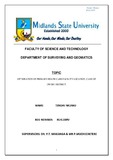Please use this identifier to cite or link to this item:
https://cris.library.msu.ac.zw//handle/11408/3509| Title: | Optimising primary health care facility location: a case of Gweru District | Authors: | Nkomo, Tendai | Keywords: | Health care Human right Zimbabwe |
Issue Date: | 2018 | Publisher: | Midlands State University | Abstract: | As access to health care is a human right in Zimbabwe it is expected that primary health facilities should be optimally located to serve demand. It is therefore a challenge for the government and policy makers to provide primary health facilities which are optimally located to serve demand conveniently. This paper highlights a GIS method for optimising location of primary health care facilities. The study area is Gweru district in Zimbabwe. Using location allocation models in ArcGIS optimal location of primary health facilities in Gweru district were selected and also the existing locations were assed to see if they are well located to serve the population as well. The important factor of locating primary health care facilities is the location of demand that require health services from a Primary health facility, here the population dataset downloaded from World pop website was used to estimate the distribution demand. Spatial accessibility is the essential principle of primary health care hence it is important to consider the relations between the location of demand, location of PHCs and the method of transport linking people with the services .in this study road network downloaded from open street was used to link facility and the demand. Also candidate facilities were obtained from the fishnet grid and the existing facilities were downloaded from the humanitarian data exchange. Maximize capacitated model was utilised to obtain the theoretical optimal location of primary health facilities in Gweru district and it was found that 68% of the population is served by the locations. Then the current distribution PHCs and their catchment area were evaluated, only 37% of the demand have good access to health care. Finally the results from the theoretical locations were compared with the existing locations. Results indicated that most of the people residing in rural areas were outside the service area as defined by the standard travel distance of 5km.The comparison results indicate that the existing facilities are not optimally located and the have low accessibility than the intended locations. | URI: | http://hdl.handle.net/11408/3509 |
| Appears in Collections: | Bsc.honours In Surveying And Geomatics |
Files in This Item:
| File | Description | Size | Format | |
|---|---|---|---|---|
| TENDAINKOMO FINAL DRAFT.pdf | Full Text | 3.32 MB | Adobe PDF |  View/Open |
Page view(s)
240
checked on Jan 15, 2025
Download(s)
430
checked on Jan 15, 2025
Google ScholarTM
Check
Items in MSUIR are protected by copyright, with all rights reserved, unless otherwise indicated.


